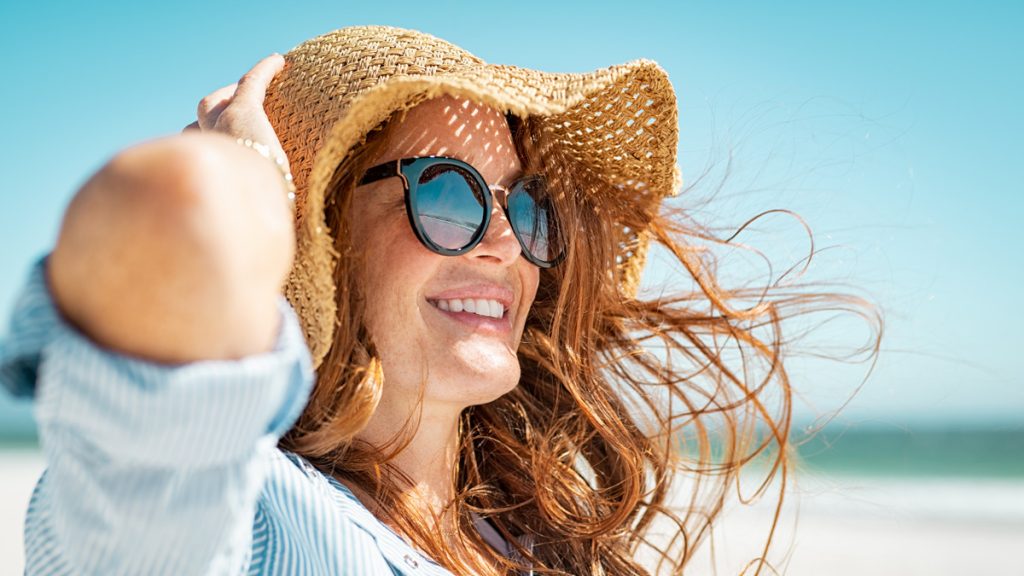Shielding Your Vision in San Diego: Understanding and Preventing Sun Damage to Eyes

Humans are sensory beings. We lead life by our senses–using sensory nerve signals from our eyes, nose, ears, and bodies to help us navigate everything from what to eat, what to wear, what might be poisonous, what sounds pleasant to the ears, and so on and so forth. Being able to smell, taste, see, feel, and hear are precious gifts that we often take for granted until they are jeopardized or taken away from us. It is our duty to protect our bodies and organs at all costs, so we can continue to experience the joys our senses bring us.
Being that we live in one of the sunniest-skied cities in the world, it can be easy to forget how powerful the sun truly is. Waltzing outside for a morning or afternoon walk without proper sun protection–for the eyes, face and body–can become a bad habit that may lead to more serious and irreversible conditions and diseases. And let us tell you, sun damage to eyes is no joke! Ultraviolet rays–specifically UV-A and UV-B rays–from the sun can lead to short and long-term eye damage and impair your vision, and it isn’t a pleasant experience!
So, how can we shield our eyes from the powerful force of the sun, while still enjoying a healthy dose of vitamin D?
Table of Contents
- Protecting Your Eyes from Sun Damage in Sunny San Diego
- Understanding Sun Damage to Eyes
- Eye Diseases Linked to Sun Damage
- San Diego’s Sunny Climate and Eye Health
- How Long Does It Take for the Sun to Damage the Eyes?
- Signs and Symptoms of Sun Damage to Eyes
- Is Sun Damage to Eyes Reversible?
- How to Treat Eye Damage from Sun Exposure
- Prevention Strategies to Protect Your Eyes From Sun Damage in Sunny San Diego
Protecting Your Eyes from Sun Damage in Sunny San Diego
UV rays change throughout the day–something you can easily check on the weather app–but no matter what level the rays are at, you should be protecting your precious eyes until the sun disappears from sight. Damage to eyes from the sun is easy to avoid, it just demands making a conscious effort to bring adequate sun protection with you everywhere you venture.
When protecting the eyes from sun damage in San Diego, opt for big, wraparound sunglasses that cover your entire eye versus sunglasses with small lenses, and snag a wide-brimmed hat–such as a bucket hat or eccentric, floppy sun hat–which provides more coverage than a baseball cap. Chilling in shaded areas such as under a tree or umbrella are also great ways to ensure your eyes are protected. Oh, and don’t stare at the sun!

Understanding Sun Damage to Eyes
So what exactly is sun damage to the eyes, and how does it occur? We know the sun is a wonder to be witnessed, but if you stare directly at the sun, the UV-A and UV-B rays can cause some serious damage, and fast. Your eyes may feel like they are sunburned. The sun is intense in San Diego–especially midday through the afternoon, as well as at higher altitudes such as hiking trails within mountainous regions.
Eye damage from the sun can even occur if you stare at something that reflects UV–say a body of water, glistening snow, concrete, sand, ice, and more. Oh, and FYI–clouds don’t block UV rays. Even if you feel it suddenly getting colder and more shady due to clouds rolling in, don’t be fooled. The sun’s rays are so strong that they can pass through haze, fog, and clouds. Believe it or not, staring at an eclipse can damage your eyes retinas and cause eye injuries known as solar retinopathy. Let’s protect the surface tissue of our eyes, our cornea and lens as they all impact our vision, and our vision not only keeps us safe but also allows us to connect to our surroundings and create deeper meanings in life.
Eye Diseases Linked to Sun Damage
Not surprisingly, sun damage can lead to more serious eye diseases and conditions–some of which require medical treatment to help alleviate. For starters, prolonged sun exposure can lead to growths on the eye, corneal damage, and macular degeneration.
Eye growths include pinguecula–which occurs on the inside or outside of the eyelid, on the surface of the membrane that lines the eyelids. It is often a yellow or whitish color. Side effects include dry eyes, inflammation, redness, and more. Excessive sun exposure on the eyes can also lead to growths on the whites of your eyes. Pterygium grows onto your cornea area and blurs vision, and in some cases you might need to get surgery to remove it. However, some corneal abrasions can heal within 24–48 hours, though it is best to stay out of the sun, as recurrent corneal abrasions can develop overtime.
Macular degeneration is an eye disease that leads to vision loss in the center of the eye, resulting in blurry vision. The cells in the macula–the part of the retina responsible for central and color vision–become destroyed. Symptoms include blank spots in the center of your vision and difficulty seeing clearly.
Another resulting eye condition from sun damage to the eyes is cataracts–cloudy or blurred vision and impaired night vision. Not using adequate eye protection can trigger or induce cataract development in young adults. Cataracts symptoms may be faded colors, light halos, challenges seeing at night or in dimly lit atmospheres, blurry and/or double vision, and beyond.
The most detrimental eye disease linked to excessive sun exposure is cancer, which you can get on your eyelids. Negative side effects of eye cancer include potential loss of eyelashes, spots on your eyelids, chronic inflammation, and many other facial changes that not only affect your appearance but also your overall wellbeing and self-confidence.
Snow blindness, otherwise known as photokeratitis, is another painful eye condition that results from staring at bright snow that reflects the sun. Photophobia, temporary vision loss, and swollen eyelids are a few symptoms one diagnosed with photokeratitis might experience. UV damage can of course also cause wrinkles and result in sagging and elasticity loss,, as well as mottled pigmentation. The defense against the sun’s harmful UV rays is so simple–why risk it for the biscuit?
San Diego’s Sunny Climate and Eye Health
Given that there are vast spans of coastline and hiking trails with little protection in our pretty city, it is important to block UV wherever you go. It is essential to wear sunglasses that block UV rays–any sunglasses that indicate that their protection level is UV 400 or with a label that says they have 100% UV-A and UV-B absorbent protection. Glasses that don’t block UV rays are essentially pretending to be effective, but truth be told, polarized lenses without a label that indicates UV protection are really just a facade. Even if your glasses are tinted, the labels will tell it all. UV-blocking properties or bust.
How Long Does It Take for the Sun to Damage the Eyes?
Sun damage can occur within the blink of an eye. Ok, not THAT quickly, but in under 2 minutes your eyes can become damaged. Of course, how long it takes for eyes to become damaged due to the sun also depends on how dilated your pupils currently are, as well as the sun’s intensity–again the UV level can be checked via the weather app.
Other factors that influence how quickly damage can occur include, geographical location–the greater you are to the equator, the higher the radiation levels. As well as wide open spaces without shaded areas. Be smart and prepare accordingly.
Signs and Symptoms of Sun Damage to Eyes
There are many ways to determine how to know if your eyes are sun damaged. For example, if you are experiencing blurred vision, sensitivity to light–either natural or artificial, red or watery eyes, puffy eyelids, overactive tear ducts, or feeling as though you have something in your eye, you’ll want to consider a visit to the eye doc stat. You might even feel a headache or migraine, which can be related to sun damage to the eyes as well. If you see floaters–black or white–or flashes of light–it’s best to contact a specialist right away.
Here’s how to recognize early signs of eye damage:
- Eye discomfort
- Eyelid twitching
- Vision impairment or loss
- Swelling
- Seeing halos around artificial or natural light
- Floaters
- Teary or red eyes
Is Sun Damage to Eyes Reversible?
Thankfully, sun damage to the eyes is reversible–to a degree. Your eyes can heal, sometimes over just a few days, if you have damage from something like snow blindness. However, other eye conditions and diseases–such as cancer–are much more difficult, if not impossible, to reverse or treat.
Ensuring maximum coverage means carefully looking at the labels of sunglasses to ensure they protect against all UV rays. Your eyes are worth the extra cost of UV blocking lenses.

How to Treat Eye Damage from Sun Exposure
If you think you may be experiencing sun damage to the eye, fret not! As mentioned, most damage is reversible, as long as it is treated within a timely fashion. Depending on what symptoms you encounter, your eye doctor may prescribe you antibiotic eye drops, as well as a mild pain reliever. A cold compress might also do the trick if you are experiencing a headache.
If you suspect you have eye damage from sun exposure, you should consult a doctor who specializes in eyes immediately upon first experiencing negative symptoms. If you aren’t currently experiencing any vision problems, it is recommended to get an eye test from an optometrist every 1-3 years. If you are over the age of forty, you should do an eye exam annually.
Prevention Strategies to Protect Your Eyes From Sun Damage in Sunny San Diego
Everyone is at risk of eye damage from the sun, but those who are out in unshaded areas where light reflection occurs for extended periods of time–such as surfers, water sport instructors, skiers and snowboarders, fisherman, and farmers, are more at risk.
Preventing eye damage due to sun boils down to routine eye exams and wearing the appropriate eyewear that protects against UV rays–such as these prescription sunglasses for men. Don’t be fooled by dark lenses–certain dark lenses can block out ambient light yet still expose you to harmful UV rays.
Before you go frolic out in the sun in a beautiful destination spot like San Diego, be sure to also pack a brimmed hat that offers some face and eye coverage, sunglasses that protect against UV rays, and sunscreen to protect your skin! Don’t be afraid to embrace the shade–an umbrella, canopy, or tent are your friends. The sun is typically strongest between 10 a.m. – 4 p.m. so keep that in mind.
If you love being able to see all the beauty in the world, you’ll be smart about avoiding sun damage to your eyes. We know you want to show off your gorgeous eye color, but it really isn’t worth it if it means short or long-term vision impairment!





